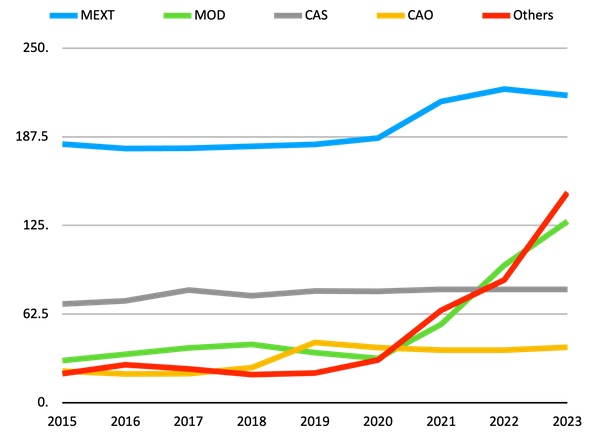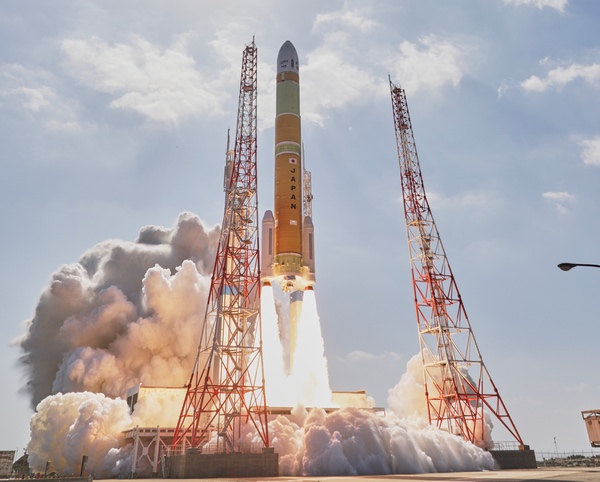A review of Japan’s space policy after the H3 launch vehicle failureby Junji Miyazawa
|
| The losses to Japan caused by this failure are immeasurable. |
In addition, the current ALOS-2 satellite is about to complete its mission and enter its late operational phase. Japan frequently experiences natural disasters such as earthquakes, heavy rains, and typhoons, and the loss of domestic remote sensing capability will be severe. For example, in the aftermath of the Great East Japan Earthquake in March 2011, the ALOS-1 satellite was used for emergency observations to assess the extent of the damage. In addition, JAXA is leading Sentinel Asia, an international cooperative project that aims to contribute to disaster management in the Asia-Pacific region by utilizing space technology. ALOS-3 was expected to contribute to Sentinel Asia and other international cooperative efforts. Japan’s loss will affect disaster prevention, security, and space exploration in the Asia-Pacific region.
According to the latest Implementation Plan of the Space Basic Plan published by the Government of Japan (GoJ) in December 2022, the Ministry of Defense’s X-band communications satellite is scheduled to be launched by the H3 vehicle at the end of Japan’s Fiscal Year (JFY) 2023, which will be March 2024. The influence of the H3 failure on the implementation plan is being reviewed within the GoJ. However, the launch date of the next H3 launch vehicle will likely be delayed for an unknown amount of time. Some estimates suggest a delay of a year or more. This situation will hinder the Ministry of Defense’s ability to obtain a new communications satellite on-orbit.
In addition, the launch of the Martian Moons eXploration (MMX), which aims to be the first sample return from Martian orbit; the Lunar Polar Exploration Mission (LUPEX), which is a joint mission with India; and the HTV-X, which is the new space station cargo resupply vehicle, are all scheduled to use the H3 launch vehicle after the end of JFY 2023. The ALOS-4 satellite and the Quasi-Zenith Satellite System MICHIBIKI-5 are scheduled to be launched by the H3 launch vehicle after JFY 2023.
It will be difficult to switch payloads to the proven H-IIA launch vehicle despite the failure of the H3 launch vehicle because satellites are designed for the specific conditions and capabilities of their launch vehicle. Therefore, Japan’s disaster risk reduction and security efforts will only produce the expected results once the causes of this launch failure are identified and remedied and the H3 launch vehicle returns to flight. Still, in light of the increased risk of disasters due to climate change and heightened political tensions among Japan’s neighboring countries, this is not a time to be leisurely. Therefore, until the H3 launch vehicle technology is proven, the GoJ should have planned to launch practical satellites for disaster risk reduction and security purposes on the more reliable H-2A launch vehicle. An alternative idea would be to use SpaceX’s Falcon 9, but that idea is unlikely to be adopted because the Basic Space Plan states that government satellites must be launched on Japan’s primary launch vehicles (either the H-IIA, the H3, or the Epsilon launch vehicle). This policy is to support Japan’s domestic space industries.
| So why did Japan launch the ALOS-3 satellite on an H3 launch vehicle instead of an H-2A launch vehicle? Reasons for this include the budgetary constraints placed on JAXA. |
Previous first flights of NASA’s, ESA’s, and Japan’s launch vehicles proceeded in different ways. The first flight of NASA’s Space Launch System, Artemis 1, was done at the same time as the test of the Orion spacecraft. The first flight of Japan’s H-2B launch vehicle was also done with the H-2 Transfer Vehicle (HTV) testing. However, Delta 4 Heavy, Antares, Falcon Heavy, and ESA’s Ariane 6 each carried, or will carry, dummy payloads or sets of small satellite as payloads on their first flights. In addition, in the case of the H-2A launch vehicle, there was a history of launching a payload for performance verification, which was affected by launch vehicle development delays. Based on these circumstances, it is not unusual for a launch vehicle’s first flight to carry a dummy payload.
If the first flight launch vehicle carries a test satellite, the budget for that satellite can be reduced. On the other hand, if not, the budget will inevitably grow because of the separate cost of launching that satellite on another launch vehicle. The launch cost of the H-2A is about 10 billion yen (about $75 million), which is inexpensive compared to the development cost of the ALOS-3 satellite. Although cost reduction sounds good, Japan has suffered a more significant loss.
So why did Japan launch the ALOS-3 satellite on an H3 launch vehicle instead of an H-2A launch vehicle? Reasons for this include the budgetary constraints placed on JAXA. The ALOS-3 satellite was initially planned to cost about 38 billion yen to develop, and the H-2A was scheduled to be its launch vehicle. Therefore, the launch cost was included in the 38-billion-yen estimate. However, the final development cost was about 28 billion yen, and the launch vehicle was changed to the H3. JAXA explained in March 2020 that the reason for choosing the H3 launch vehicle for launching the ALOS-3 satellite was “a business decision” based on the number of the H-2A vehicles remaining and other various circumstances. Among the other various circumstances, there may have been a diversion of costs associated with the delay in the development of the H3. In other words, by shifting the H-2A from the ALOS-3 satellite to launch other government satellites and placing the ALOS-3 satellite on the H3, the development cost of the H3 was increased by about 10 billion yen.
The graph below shows the budgets of the Ministry of Education, Culture, Sports, Science and Technology (MEXT), the Ministry of Defense (MOD), the Cabinet Office (CAO), and the Cabinet Secretariat (CAS) and the total budget of other ministries (in billions of yen) since JFY 2015. Since the budget provided to JAXA is almost entirely through MEXT, its budget is used in this review. And the total budget of other ministries consists of the budgets of the Ministry of Internal Affairs and Communications (MIC), the Ministry of Economy, Trade and Industry (METI), the Ministry of Land, Infrastructure, Transport and Tourism (MLIT), the Ministry of Environment (MOE), the Ministry of Agriculture, Forestry and Fisheries (MAFF), the Ministry of Foreign Affairs (MOFA), and the National Police Agency (NPA). MEXT’s budget has shown that it has remained essentially flat through JFY 2019. And CAS’s budget, which covers expenses related to developing and operating information-gathering satellites, has remained largely unchanged. On the other hand, other ministries’ budgets are increasing. For example, CAO’s budget doubled in JFY 2019. This increase was due to the cost of developing, maintaining, and operating the MICHIBIKI series. Also, MOD’s budget has increased by 20 to 30 billion yen annually since 2021 (the JFY 2023 budget is about four times the JFY 2020 budget) due to the strengthening of space situational awareness capabilities.
 The budgets for various Japanese agencies working on space programs, in billions of yen. |
Additionally, the total budget of other ministries has increased sevenfold between JFY 2019 and 2023. The overall budget increase from JFY 2020 onward can be attributed to the decision to participate in the Artemis program in October 2019 and the government’s policy of significant increases in other space-related budgets. This increase means that the GoJ is becoming more active in space utilization.
Five launches of the H-IIA launch vehicles are scheduled in the future: three Information Gathering Satellites, the Global Observing SATellite for Greenhouse gases and Water cycle (GOSAT-GW), and the X-Ray Imaging and Spectroscopy Mission (XRISM) with the Smart Lander for Investigating Moon (SLIM). Given the reasons mentioned above for JAXA’s decision to launch the ALOS-3 satellite on the H3, it is clear that the more essential satellites were assigned to the H-2A; that is, the ALOS-3 satellite had less policy importance compared to intelligence gathering satellites, SLIM, and others. It is clear that security and international space exploration are a focus of the GoJ, even from a non-budgetary perspective.
| For Japan to be a leading spacefaring nation, it is crucial to develop cutting-edge space technology and make greater efforts to utilize space for practical applications. |
The reason why the H-2A was assigned to the GOSAT-GW satellite instead of the ALOS-3 satellite may be because the ALOS-3 satellite was developed solely by MEXT/JAXA. On the other hand, the GOSAT-GW satellite is being developed under shared responsibility with MOE. The GOSAT-GW satellite is also expected to contribute to the global stocktaking of the Paris Agreement. This means that, unlike the ALOS-3 satellite, it is difficult for the GOSAT-GW satellite to divert budgets or change transport vehicles at the sole discretion of MEXT/JAXA. JAXA’s activities are not necessarily funded only by the operating budget from MEXT but can also be financed by commissioned contracts and grants from other ministries. For example, in the case of the ALOS-3 satellite, these ministries include MLIT from the perspective of disaster risk reduction and national land management and MAFF from the perspective of agricultural fields and forest management. Both MLIT and MAFF are expected to use the satellite’s data.
To this end, the Consortium for Satellite Earth Observation (CONSEO), led by JAXA, was established in September 2022. This consortium is intended to provide a framework for discussions that will lead to overall strategies and policy proposals for future earth observation satellites in Japan, with participation from industry, academia, and government. The CONSEO also published its first proposal in March 2023.
In its first proposal, the consortium states that government Earth observation missions are indispensable for promoting data utilization and social applications, maintaining and developing industrial infrastructure, and promoting international cooperation. Therefore, predictability and continuity of the missions must be ensured. In other words, the consortium seeks to develop an infrastructure of governmental Earth observation satellites. In addition, it requires the GoJ to establish a new strategic earth observation program to contribute to foreign policy, such as strengthening the Japan-US alliance, the Quad (US, Japan, India, and Australia), and economic security. At the same time, it also calls for Japan to acquire global strategic indispensability in the Earth observation fields of greenhouse gases, the water cycle, forests, and other areas. If the GoJ takes up this proposal, it will no longer be allowed to have gaps in Earth observations. The GoJ should positively consider accepting the proposal and continue to devote sufficient resources to the field of Earth observation, bearing in mind that the proposal reflects the firm opinions of industry and academia.
For Japan to be a leading spacefaring nation, it is crucial to develop cutting-edge space technology and make greater efforts to utilize space for practical applications. Earth observation satellites are in increasing demand for disaster risk reduction, security, and international cooperation and diplomacy. Therefore, the CONSEO seeks continuous acquisition of Earth observation data through the infrastructure of governmental satellites. However, with the failure of the H3 launch, the Japanese government faces a significant gap in optical land observation data. This review suggests two ways that the GoJ can avoid such a situation in the future, based on the above discussion of how current situation came about. The first is that a dummy payload should be used for the first flight test of a new launch vehicle. For this purpose, it is necessary to allocate a sufficient budget to put a dummy payload on board. The second is that not only MEXT/JAXA, but also the relevant ministries and agencies that will use satellite data and services, should actively participate in the development process and equitably bear the development costs and risks when developing and manufacturing new governmental satellites in the future.
Note: we are using a new commenting system, which may require you to create a new account.
